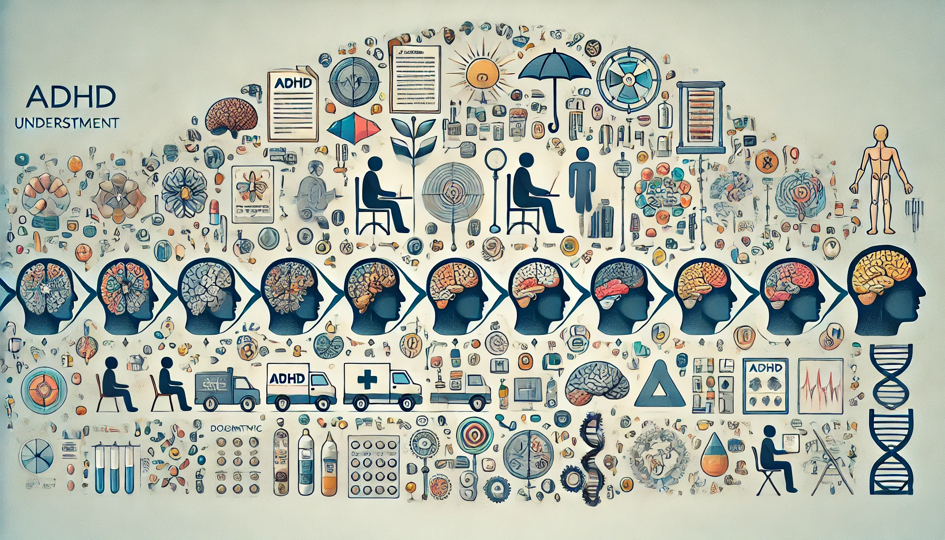
ADHD is a condition that has been recognized for decades, yet it is only in recent years that our understanding of its complexities has deepened. Today, ADHD affects millions worldwide, transcending age, gender, and culture. Since this is ADHD Awareness Month, it seems appropriate to review how far our understanding of the condition has come—from early recognition to the latest in diagnostics and treatment.
A Brief History of ADHD as a Recognized Condition
ADHD is more common than many realize. In the United States, approximately 11.4% of children aged 3-17 have been diagnosed with ADHD at some point, according to data from the Centers for Disease Control and Prevention (CDC). Among adults, about 4.4% are diagnosed, though the true prevalence may be higher due to underdiagnosis. For women and older adults, the numbers are rising, driven by better awareness and more accurate diagnostics. These statistics show that ADHD is not just a childhood issue but a lifelong condition that can significantly impact quality of life if not properly managed.
ADHD’s roots go back further than many think. In the early 20th century, the symptoms we now associate with ADHD were first described by Dr. George Still in 1902. He identified a “defect of moral control” in children who struggled to control their impulses and attention despite average or above-average intelligence. Over time, this understanding evolved, and by the 1960s, hyperactivity was a central focus of the condition—hence the early name “Hyperkinetic Reaction of Childhood.”
It wasn’t until the late 1980s that the term “Attention Deficit Hyperactivity Disorder” was formally adopted, emphasizing that hyperactivity was just one potential aspect of the condition. Since then, the diagnostic criteria have continued to evolve, reflecting our growing understanding that ADHD presents in various ways, beyond hyperactive behavior.
Progress in Diagnosing Women and Older Adults
Historically, ADHD was primarily associated with young, hyperactive boys. This stereotype left many people—particularly women and older adults—undiagnosed for years. Women often exhibit more inattentive symptoms rather than hyperactivity, which made their ADHD more likely to be overlooked or mistaken for anxiety or depression.
The good news is that awareness has improved significantly. More healthcare professionals are now recognizing the subtle manifestations of ADHD, leading to better identification in populations that were previously underdiagnosed. Today, many women are receiving diagnoses for the first time as adults, often prompted by their own children’s diagnosis, which can be a powerful, validating experience.
The Evolution and Future of Diagnostic Techniques
Diagnosing ADHD has historically relied on behavioral assessments, involving self-reports, parent interviews, and teacher observations. These tools, while valuable, are subjective. In recent years, we’ve seen exciting progress in refining diagnostic techniques.
Researchers have explored brain imaging, such as functional MRIs, to understand how the brains of individuals with ADHD differ from those without the condition. Although imaging isn’t yet used in routine diagnosis, these studies are helping identify patterns in brain activity that could become valuable markers.
Beyond imaging, there’s growing interest in finding biological markers—such as genetic traits or specific proteins in the blood—that could make diagnosis more objective. Genetic research has already identified certain genes linked to ADHD, and while we’re not yet at the stage of a simple blood test or genetic screen for diagnosis, these developments hint at a future where diagnosing ADHD could be much more precise and personalized.
Treatment Options: From Stimulants to Lifestyle Strategies
Treatment for ADHD has evolved tremendously. In the 1930s, stimulant medications like Benzedrine were found to improve concentration in children, paving the way for the use of medications such as Ritalin and Adderall, which are still widely prescribed today. These stimulants help balance neurotransmitters in the brain, improving focus and impulse control.
Beyond medication, behavioral therapy became an important part of ADHD treatment, particularly for children. Cognitive Behavioral Therapy (CBT) is now commonly used to help individuals develop coping strategies, manage impulsivity, and improve organization skills.
In recent years, alternative treatments have also gained traction. Mindfulness practices, regular exercise, and dietary adjustments have all been shown to have positive effects on ADHD symptoms. Coaching, particularly executive function coaching, has emerged as a valuable resource for helping individuals with ADHD set goals, manage time, and create effective routines. This holistic approach reflects our growing recognition that ADHD affects multiple aspects of life and requires a comprehensive, individualized treatment plan.
The Road Ahead
As our understanding of ADHD continues to evolve, so too do the tools and treatments available. The future may see a blend of behavioral assessments, genetic insights, and advanced imaging techniques for accurate, early diagnosis. Treatment will likely continue to expand beyond medication, incorporating digital therapeutics, biofeedback, and personalized coaching.
We’re making incredible strides, but it’s important to remember that ADHD is not a “one-size-fits-all” condition. Each individual has their own unique strengths and challenges, and the most effective approaches are those that recognize and honor this individuality. With greater awareness, empathy, and scientific advancements, we can continue to help those with ADHD not just cope but thrive.
References
- https://www.cdc.gov/adhd/data/index.html—
- https://www.healthline.com/health/adhd/history#1902—
- https://www.additudemag.com/epigenetics-neuroimaging-brain-training-adhd-research/—
- https://www.verywellmind.com/adhd-history-of-adhd-2633127—
- https://chadd.org/adhd-news/adhd-news-adults/could-ai-be-the-future-of-adhd-diagnosis/—


